
La Etapa Reina del Annapurna Circuit y el motivo por el que muchos venimos a Nepal. El día marcado en rojo en el calendario desde el momento en que empezamos a planear el viaje. El nombre que se escucha, Thorong La, como un tímido susurro en el barrio mochilero de Kathmandu y que está detrás de cada conversación a medida que vamos quemando etapas del circuito. El objetivo que nos empuja a seguir en los días duros y que nos obliga a ser cautos y prudentes en los días buenos. La motivación que hace que las piernas, cada vez más cansadas, no transijan y sigan caminando con decisión a pesar de la dureza del camino. Un estricto profesor con el que se aprende a ser paciente, constante, humilde y silenciosamente orgulloso. Una épica ascensión hasta 5416 m de altitud en la que no se alcanza ninguna mítica cumbre de los Himalayas, sino un paso de montaña, Thorong La, el conocido como mayor paso de montaña del planeta. A ambos lados del paso, como centinelas de piedra de edades antiguas se alzan gallardos el Thorong Peak (6144 m) y el Yakwakang (6482 m), vigías atentos a las aventuras y desventuras de los bravos montañeros que, cerca de la frontera de sus límites físicos y mentales, escalan, superan y conquistan sus objetivos, sus miedos, sus cimas y su cielo.

El día empezó para nosotros a las 04:30, levantándonos todavía con ganas de quedarnos en el saco haciendo perecitas, forzándonos a desayunar lo que buenamente apetece comer a esas horas.


A las 05:00 abandonamos la seguridad del albergue vestidos con la ropa térmica que llevábamos cargando todo el viaje, por fin la necesitábamos.

Fuimos el tercer grupo en salir aquella mañana: nos precedían un padre y un hijo de Alemania y una señora también alemana que iba con un adolescente nepalés hijo de unos amigos suyos. Después de nosotros saldría un trío de Barcelona: Gemma, Xavier y Manuela. Todos acabamos encontrándonos en Thorong La.


La ascensión hasta el High Camp fue algo más pesada con las mochilas, pero al ir todavía adormecidos casi no nos dimos cuenta.

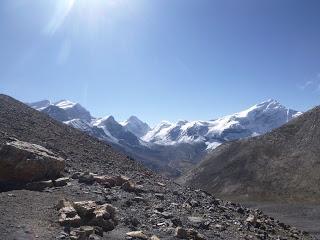
Una vez pasado el High Camp la subida se suaviza considerablemente pero la altitud se nota mucho más. El aire te llena los pulmones pero el oxígeno es escaso. Es una sensación muy curiosa, como si el aire estuviese soso. Como tomar una sopa donde en lugar de un buen caldo lo que han puesto es agua caliente: sabes que estás comiendo pero no te estás alimentando.

La subida no es pronunciada en absoluto, las mochilas no pesan ninguna barbaridad y menos ahora que llevamos la ropa térmica y las chaquetas puestas (unos 5 kg cada mochila), vamos bien alimentados y bebemos todo el agua que nos apetece. Además los cuatro valientes, Cristian, Stefan, Marina y yo, estamos en bastante buena forma física. Una subida igual la haríamos en casa cargados con mochilas tres veces más pesadas casi sin darnos cuenta.


Y ahora viene lo curioso. No se nota cansancio muscular en absoluto. Las piernas responden perfectamente y no se experimenta esa sensación muscular de ardor y presión típica en los gemelos y los muslos que ocurre cuando fuerzas en las subidas. Y aquí precisamente es donde la gente la caga.

Así como los músculos podrían llevarnos mucho más rápido o por lo menos a un ritmo más alegre, los pulmones no podrían seguirlos ya que, por mucho que la aclimatación haya sido buena, el cuerpo no está aún preparado para recuperarse de un esfuerzo intenso con la baja concentración de oxígeno que hay a esta altitud.

Esto te lo cuentan y no te lo crees, porque te encuentras realmente fuerte y animado, y es por eso que las excursiones de aclimatación al Ice Lake y al High Camp el día anterior son tan buenas, porque puedes utilizarlas para experimentar. Gracias a esto ya no es un “me han contado” o “he leído” sino un “lo he vivido hace dos días”.


El error que hay que evitar es el de caminar al mismo ritmo que llevaríamos en una excursión normal en Nueva Zelanda, Chile o Alemania. Hay que forzarse a caminar lento, a no sofocarse, a no necesitar parar para recuperarse. Y esto no es fácil. La gente se levanta fresca por la mañana, pasan la fuerte subida al High Camp con solvencia y luego se confían y suben el ritmo y es ahí cuando firman su sentencia.
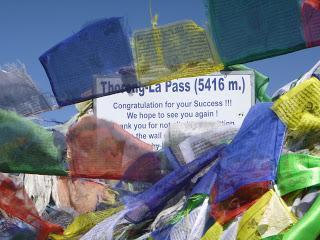

En nuestro día fuimos únicamente 11 personas cruzando Thorong La y no tuvimos ningún problema, pero en temporada alta son aproximadamente 100 al día, y las historias que cuentan los dueños del campo base dan miedo (evacuaciones en helicóptero de forma regular, llamadas a la embajada, carreras montaña abajo en mitad de la noche…).


Íbamos nosotros caminando a nuestro ritmo, en fila india y marcando muy bien el paso, cuando empezamos a escuchar el sonido de unos bastones y unos pasos bastante acelerados. Nos giramos y vemos que Xavier viene como una locomotora a un ritmo de vértigo. Nos adelanta y desaparece montaña arriba. Pasado un rato Gemma se nos acerca por detrás y camina con nosotros. Al rato vemos que Xavier baja sin mochila y prácticamente corriendo, se acerca a Gemma, coge su mochila y se van los dos cuesta arriba dejándonos atrás.

A las 09:30, algo más de cuatro horas después de empezar y habiendo pasado infinidad de falsos pasos, vemos la montaña de Lungtas que marca el punto más elevado de Thorong La, a 5416 m. Apartado nos encontramos a Xavier que ya va por su tercer cigarrillo. Estando todavía anonadados Gemma nos cuenta que en enero le operaron un pulmón.




En Thorong La acabamos encontrándonos todos: el padre e hijo alemanes, la señora alemana con el joven nepalés, el trío de Barcelona y nosotros: Cristian Jáuregui de Chile, Stefan Grabke de Múnich, Marina Cano de Vilanova i la Geltrú y yo, Enrique de Azcoitia también de Barcelona. Para celebrar el éxito de la expedición nos comimos las chocolatinas que compramos en Manang, el chocolate de la victoria.


Pasado un rato en el que tuvimos tiempo de hacer todas las fotos que quisimos tocaba ya bajar hacia Muktinath, lugar milenario de peregrinación para los hindúes.


La bajada la verdad que se las trae. Es muy empinada y larga y es de grava suelta por lo que los resbalones son constantes. El momento surrealista del día sucedió cuando, ya a punto de llegar a Muktinath nos encontramos con una pareja de ingleses vestidos como si estuviesen en Salou: camisetas de publicidad de un centro de buceo, traje de baño él y pantalones jipis ella, sandalias de río, gorros de colorines de los que los hooligans llevan a los estadios de futbol, dos mochilas microscópicas y una caña de pescar. Resulta que estaban por la zona y habían decidido en un impulso que querían subir a Thorong La, como quien va a tomar unas bravas a Gavà. Nos despedimos de ellos buscando la cámara oculta y aún hoy nos arrepentimos de no haberles hecho una foto. Esperamos que sigan vivos.

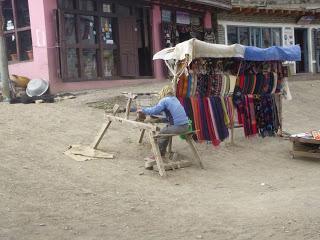

En Muktinath acabamos alojándonos en el Hotel Bob Marley donde, casualidades, estábamos todos los que habíamos cruzado Thorong La. Para celebrar la gesta del día cenamos una hamburguesa de yak que supo a gloria.RESUMEN DE LA ETAPA:Fecha: 10 de junio de 2016Hora y altitud de partida: 05:00 a 4450 mAltitud máxima alcanzada: 5416 mHora y altitud de llegada: 14:30 a 3760 mDistancia: 15,6 kmTipo de vía: CaminoClimatología: Alta montaña Condiciones meteorológicas: SoleadoAlojamiento: Hotel Bob Marley con cama gratis y ducha de agua caliente.Precio del Dal Bhat: 500 Rs
Enrique & MarinaEnglish versionANNAPURNA CIRCUIT DAY 8: THORONG PEDI (4450 m) - THORONG LA PASS (5416 m) - MUKTINATH (3760 m)

This is the highlight of the Annapurna Circuit and the reason many people come to Nepal. It’s the day you mark in your calendar and the date you plan your trip around of. It’s the place people whispers about in Thamel and also the topic of most conversations that fill the afternoons in the teahouses. Thorong La is the target, the reason to carry on walking day after day despite our tired bodies and the roughness of the terrain and the conditions. A goal that can only be achieved through patience, perseverance and humility. Funny enough, the epic ascend to 5416 m doesn’t take you to any of the Himalayan summits but to the World’s Biggest Pass where Thorong Peak (6144 m) and Yakwakang (6482 m) stand on each side as a couple of vigilant guards for all the trekkers.

For us, the day started at 4.30 AM struggling to get out of bed and trying to ingest something even though not much is really appetising at that time.


By 5:00 AM we were leaving the warm guesthouse dressed with all the thermal clothes that we’d been carrying for 7 days in the backpack. At last we were using that gear!

We were the third group leaving the house that morning. Ahead of us we had a father and his son from Germany and another German lady based in the US travelling with a Nepali teenage guy who was the son of some friends of her. And after us we had a trio from Barcelona: Gemma, Xavier and Manuela.


The ascend to High Camp was understandably harder this time that we carried our big backpacks but we were still half sleep, so we don’t remember much of that pain.

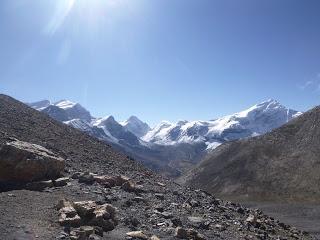
At High Camp I was already sick of my thick thermal pants so I went into the highest toilet I’ve ever been in my life and peel them off. Much better! The track becomes less steep after that but it’s when the altitude adds the most to the challenge. That thin air fills your lungs but the oxygen available is very little. Enrique says it’s like having a soup made with water instead of broth, the air lacks seasoning and flavour: there’s no real goodness in there.

The trail is not hard, our backpacks are pretty light particularly today that we’re wearing several layers and our jackets, let’s say about 5 kilos, we’re well rested and fed and we’re drinking plenty of water. The four of us, Cristian, Stefan, Enrique and me, are pretty fit. We’d do that same climb at our own homes like a Sunday walk.


There’s no muscular fatigue. Our legs worked on the automatic pilot and we didn’t feel that burning sensation that we get when running up Mt Alfred at all. And that’s how altitude tricks you.

Yeah, because your muscles can do more but your lungs can’t. Despite a good acclimatisation, normal people’s (who don’t live in high countries and don’t spend so much time in the mountains) bodies are not ready to recover from an intense effort using such a small concentration of oxygen.

People along the trail tells you that and you don’t believe them because you’re feeling strong, positive and motivated. And for this reason it’s so important to go walking on rest/acclimatisation days, not only to get used to altitude but most important to experience first hand what really goes on up there. We all know that it’s not the same “what someone told me” or “what I’ve heard” than “what I felt two days ago”.


Over all, our advice, if anyone wants to take it, is not to forget that you’re not in New Zealand, Chile or Germany and the pace needs to be slower. You need to force your will to slow down in order to never become out of breath. And that is extremely difficult because you’ll wake up fresh and full of energy but since you’re not pushing you’ll get impatient and will rise the speed… Mistake done.


On the day we crossed the pass, we were only 11 people on the trail and we were all fine. However, in high season there’re 100+ trekkers attempting that same crossing daily and that makes stories to write several books. Mostly horror stories: heli-evacuations on a regular basis, calls to the embassy for help, runs down the mountain in the middle of the night, among others.


Anyway, we walked at our (slow) pace in a single line when we heard the noise of a fast paced pair of trekking poles getting closer. As we turned around we saw Xavier speeding towards us. He overtook us, said good morning and kept going up the mountain. A while after, Gemma caught us, spend a few minutes talking to us and eventually carried on at her faster pace. While she was still in our sight, we saw Xavier again coming down the hill very fast and without any backpack. He picked up his girlfriend’s pack and off they went.

At 9.30 AM, about four hours after we stared that day and having seen plenty of false passes, we spotted the mess of Lungtas that marked the highest point of Thorong La, at 5416 m. In a corner, we could see Xavier again, smoking his third cigarette. Still in shock, Gemma tells us that he had had surgery in this lung in January.




In Thorong La we met everyone who was crossing the pass that day: the German dad and son, the German lady travelling with her Nepali friend, the trio from Barcelona and us: Cristian Jáuregui from Chile, Stefan Grabke from Munich, Marina Cano from Vilanova i la Geltrú and, Enrique de Azcoitia also from Barcelona. To celebrate our success we all ate the chocolates of the victory that we bought in Manang.
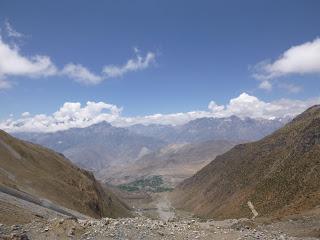
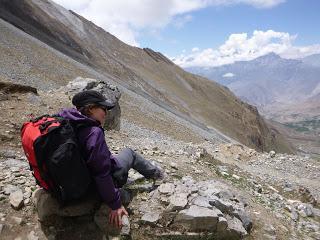
We spent some time enjoying the views, taking pictures and congratulating ourselves until we decided it was time to start getting down to Muktinath, a pilgrimage destination that Hindus have been visiting for millenniums.


The way down wasn’t any easier than the way up. It was a steep and long track with a loose and slippery surface.Then, we experience the surreal event of the day. Nearly at Muktinath, we met a couple from England dressed like in the beach: t-shirts from a diving center, swimming shorts him and hippy/thai pants her, sandals, two small day packs and a fishing rod. They stopped and asked how was up there. We told them how nice and cool it was and they told us that they spontaneously decided to try to climb to Thorong La from Muktinath since they were in the area. Just like that. We told them about all the gear we though they may need, gave them a few tips about altitude and wished them good luck as they left. We even thought that it was a joke and that one of those hidden cameras will show up after. We still regret not to have taken a photo with them. Hopefully they’re still alive.
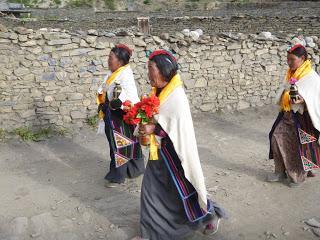


At the end of the day, in Muktinath, we took rooms at the Bob Marley Hotel where, by sheer chance, everyone who crossed the pass that day stayed too. We had an awesome shower and skipped our temporary vegetarian diet and had yak burger to celebrate the achievement since it seem safe to eat meat in that place. STAGE OVERVIEW:Date: 10th of June 2016Start time and altitude: 05:00 at 4450 mHighest altitude: 5416 mFinish time and altitude: 14:30 at 3760 mDistancia: 15.6 kmType of track: TrackClimate: Alpine Weather on the day: SunnyAccommodation: Bob Marley Hotel. Free room, shared hot water shower and toilet. Price of Dal Bhat: 500 RsEnrique & Marina
